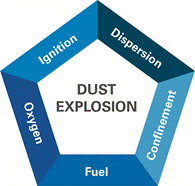VOLUME 02
February 2020
ISSUE 02
Grain Elevator and Bin Explosions
Dust Hazard Analysis
According to OSHA, over the last 35 years there have been over 500 explosions in grain handling facilities across the United States. These incidents have reportedly killed more than 180 people and injured more than 675. The total number of incidents is uncertain for small family farms that have been historically unregulated by OSHA. However, fires and explosions can occur at both large and small operations where grain elevators and grain bins are used. These fires can result in loss of life, injury, downtime and substantial property damage.In order for a grain dust explosion to occur, five elements; fuel, oxygen, ignition source, dispersions of dust and confinement must be present. All of the five elements are typically present at a grain handling location.
Development of Grain Dust Explosions
Storage of grain in bins provides the perfect environment for fires and explosions. A grain bin can be considered a confined space and typically has an oxygenated environment. This satisfies two of the five requirements in the dust pentagon. When grain is added or disturbed, the agitation disrupts the contents and produces a large amount of dust that will be suspended in the airspace. The resulting dust cloud satisfies the dispersion and fuel element in the pentagon. According to a report from Purdue University, the most common months for grain explosions are April, August and September. This coincides with increased movement of grain associated with the sale, harvesting, loading and unloading of grain.

These activities increase turbulence in the bin and allow for large amounts of grain dust to become released and suspended in the airspace. This not only includes dust from the grain being deposited into the bin, but also stirs up dust that has previously settled on surfaces in the bin. Grain dust is highly flammable and combustible and in the right conditions, one spark can create an explosion.
Ignition sources are quite common and readily available in grain handling industries. Static electricity, welding and maintenance activities, smoking, lightening, a light switch or friction on belts or bearings within the grain elevator are just some of the sources that can create a spark that can lead to an explosion. Since only a small amount of energy is needed to ignite suspended grain dust, many potential ignition sources can readily supply the needed energy for an explosion.
Explosions in grain bins are typically a two phase event. The primary explosions occur when grain dust is suspended in the air in adequate concentrations and trapped within an enclosed space. When heat or an ignition source is introduced, a fire and/or an explosion can occur. This initial or primary explosion can disturb large amounts of dust that has settled on surfaces over time and expel them into the air as additional fuel. Once this additional dust ignites, a secondary explosion or flash fire can occur. With the increased volume of combustible dust, the secondary explosions can be much more destructive than the primary explosion. These explosions are so catastrophic and destructive that in many incidents an ignition and/or fuel source might not be conclusively identified.

Explosions in grain bins are typically a two phase event. The primary explosions occur when grain dust is suspended in the air in adequate concentrations and trapped within an enclosed space. When heat or an ignition source is introduced, a fire and/or an explosion can occur. This initial or primary explosion can disturb large amounts of dust that has settled on surfaces over time and expel them into the air as additional fuel. Once this additional dust ignites, a secondary explosion or flash fire can occur. With the increased volume of combustible dust, the secondary explosions can be much more destructive than the primary explosion. These explosions are so catastrophic and destructive that in many incidents an ignition and/or fuel source might not be conclusively identified.
The National Fire Prevention Association (NFPA) offers guidance and standards for grain handling industries. NFPA 61 is the industry specific standard for the Prevention of Fires and Dust Explosions in Agricultural and Food Processing Facilities. However, in 2015 NFPA 652: Standard on the Fundamentals of Combustible Dust was introduced. This provided one standard for managing combustible dust fire and explosions hazards in all types of industries, including grain handling. This update requires industries with combustible dust to complete a comprehensive Dust Hazard Analysis (DHA) of their facilities by September 7, 2020. These locations must also begin to initiate action steps to reduce any potential combustible dust hazards.
A complete Dust Hazard Analysis will reveal dust hazards that can lead to fires and explosions and is crucial in providing a safe work environment. If a DHA has not been initiated, or if you have questions or need assistance with the requirements of NFPA 652, please call or email our office. We are well equipped to assist you with your Dust Hazard Analysis.
Conclusion
Investigating a fire and/or explosion at a grain handling site requires a team that has experience in combustible dust explosions, NFPA 921, scientific methodology, bin design, controls and housekeeping practices. The team at Gossman Forensics has the background in OSHA grain handling standards and best practices, NFPA standards and dust hazard analysis, grain bin design and engineering controls to effectively evaluate an incident scene.
2 OSHA.gov